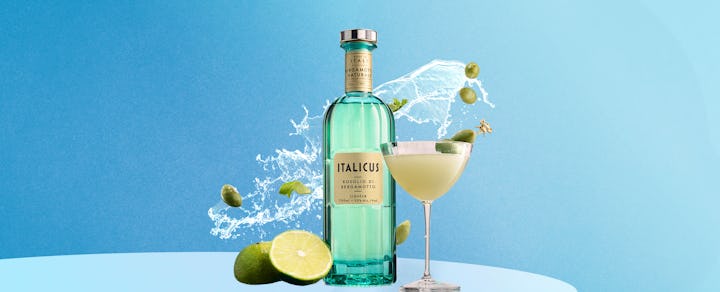Italicus Is The Ideal Way to Kick Up Your Spritz
The award-winning bergamot-forward liqueur adds both sweet and bitter notes to cocktails — and is especially great in a spritz.

Summer is nearly here, which means it's the ideal time to relax with a spritz cocktail. Your basic spritz recipe includes sparkling wine, soda water, and an amaro — a bitter liqueur. It’s that last ingredient that varies depending on your taste and style, from the sweet elderberry flavor of Saint Germain to the bitter red hue of Campari. The Aperol Spritz may be the most common of these sparkling concoctions, but if you really want to elevate your spritz game, reach for Italicus, an aperitif once embraced by Italian royalty.
Every product you find here is independently selected by our editors, writers, and experts. If you click a link on our site and buy something, we may earn an affiliate commission.
What Is Italicus?
Italicus is the brand name for a rosolio aperitif. Contrary to intuition, it is not derived from roses. Rather, Italicus is a rosolio di bergamotto. Translated from Italian, it’s the “morning dew of bergamots.”
Grown under the warm, Mediterranean sun, bergamots are a type of citrus fruit that’s a cross between a bitter orange and a lemon, with a primary green color that turns yellow as it ripens. Rarely eaten due to its bitterness, it's quite perfect to make a clear, bitter amaro with a slight greenish tint. Unlike Aperol, which leans on the sweet side, Italicus has a nice balance of sweetness and bitterness, with a pleasant floral fragrance that hits your nose with each sip.
This harmonious elegance was embraced by the King of Savoy during the 18th century, in what is now northwestern Italy. Then, rosolio was the Aperitivo di Corte (Aperitif of the Court) but went forgotten for centuries. It wasn’t until 2016 that Italian mixologist Giuseppe Gallo from the Amalfi Coast resurrected the bygone recipe, and bottled it as the ultimate expression of his homeland.
Italicus’ ingredients come from different regions of Italy: the bergamots are sourced from a UNESCO-protected region in Calabria; the cedro (citron) is from Sicily; the chamomile is from Lazio; and the other fragrant herbs — including lemon balm, lavender, yellow roses, and gentian — hail from northern Italy.
If the inside of the bottle isn’t Italian enough, consider the bottle itself. The elegantly ribbed glass has a hue of aquamarine, representing the waters of the Amalfi Coast. The stopper features an image of Bacchus, the God of Wine, in the Vitruvian Man pose by Da Vinci. And on the upper label, it proudly claims to contain “a sip of Italy,” with a celebratory “Salute!”
What’s The Best Way to Use Italicus?
This Italian spirit of Italian spirits has garnered dozens of awards since its introduction, including a Gold Medal and designation as Italian Aperitif of the Year in 2021 by the New York International Spirits Competition. It’s well suited for Italicus Spritzes (obviously) — just make sure you use prosecco for the sparkling wine component to keep it Italian.
You can also craft other Italicus cocktails, from margaritas to negronis, or any drink that could use a floral hint of bitterness and sweetness. However, in keeping with Italicus’ intention, it’s important to garnish any Italicus-forward cocktail with three olives — to round out its flavor profile with a hint of saltiness.
Two Italicus Cocktails to Try
1. The Italicus Spritz
Ingredients
- 1 part Italicus Rosolio di Bergamotto
- 2 parts Prosecco (or Champagne)
- Olives
Directions
Build in a tumbler glass with cubed ice and garnish with three olives.
2. The Italicus Margarita
Ingredients
- 2 parts Italicus Rosolio di Bergamotto
- 2 parts Tequila Blanco
- 1 part lime juice
- 1 bar spoon agave nectar
Directions
Shake and serve straight up in a coupette glass. Garnish with lime zest and three green olives